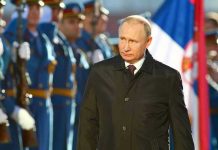
President Trump publicly berates Federal Reserve Chair Jerome Powell over interest rate decisions, sparking debate about central bank independence amid market volatility.
Key Takeaways
- President Trump criticized Fed Chair Powell for not cutting interest rates, blaming him for recent stock market declines
- Trump suggested Powell should be fired, highlighting that the European Central Bank is already cutting rates while the U.S. Fed maintains current levels
- Powell has defended the Federal Reserve’s independence, stating decisions are based on economic data, not political pressure
- Powell warned that Trump’s proposed tariffs could lead to inflation and job losses, potentially justifying his cautious approach
- Despite Trump’s threats, Powell maintains that the president lacks the authority to remove him from his position before his term ends in 2026
Trump’s Public Rebuke of Fed Chair
President Donald Trump has intensified his criticism of Federal Reserve Chair Jerome Powell, calling for his termination over what Trump perceives as Powell’s failure to cut interest rates. As markets experienced turbulence, Trump expressed frustration that Powell’s reluctance to lower rates was hampering economic growth and contributing to stock market volatility. The president’s comments came as the European Central Bank has already begun reducing rates, creating what Trump sees as a competitive disadvantage for the United States in the global economy.
Trump specifically accused Powell of issuing a “complete mess” of a report and being “too late” in making crucial economic decisions compared to European counterparts. The timing of Trump’s criticism coincides with market uncertainty as investors watch for signs of when the Federal Reserve might finally begin its own rate-cutting cycle. This public confrontation has raised questions about the relationship between the White House and what has traditionally been an independent economic institution.
Why is the #US stock market falling?
While Trump’s #tariffs are the biggest and most immediate trigger for the sharp selloff in the US stock market, several other key factors also appear to have contributed to the downtrend on Wall Street.
1. Trade war jitters:
Trump's… pic.twitter.com/vPJmWjfQDG
— Markets Today (@marketsday) April 5, 2025
Fed Independence Under Pressure
Powell, originally nominated by Trump in 2017 and later renominated by President Biden in 2021, has repeatedly defended the Federal Reserve’s independence from political influence. His current term runs until May 2026, creating a potentially lengthy period of tension if the relationship with the White House remains strained. Despite the public pressure, Powell has maintained that the Fed’s decisions are based solely on economic data and analysis, not political considerations or executive directives.
“Generally speaking, Fed independence is very widely understood and supported in Washington, in Congress, where it really matters,” said Jerome Powell.
Powell has further justified his cautious approach by pointing to potential economic challenges on the horizon. He recently suggested that Trump’s proposed tariff policies could trigger inflation and job losses, arguments that provide economic rationale for maintaining higher interest rates. This direct connection between presidential policy proposals and monetary decisions has further inflamed tensions between the administration and the central bank, with each side holding firm to their respective positions.
A History of Central Bank Conflicts
The current friction marks a continuation of Trump’s previously contentious relationship with Powell during his first administration. Trump has a documented history of criticizing Powell and has previously threatened to fire him, though such authority is questionable. When faced with similar threats in the past, Powell has explicitly stated that the president lacks the legal authority to remove a Fed chair before their term expires, reinforcing the institution’s design as a politically independent economic body.
“We’re never going to be influenced by any political pressure. People can say whatever they want. That’s fine with — that’s not a problem, but we will do what we do strictly without consideration of political or any other extraneous factors,” Jerome Powell said.
Financial markets are closely monitoring this developing tension, as uncertainty about the Federal Reserve’s independence could introduce additional volatility. The conflict highlights broader questions about economic policy direction and the balance of power between the White House and the central bank. Investors and economists alike are watching to see whether Powell will maintain his data-driven approach to monetary policy or if political pressure might eventually influence the timing and magnitude of future interest rate decisions.














